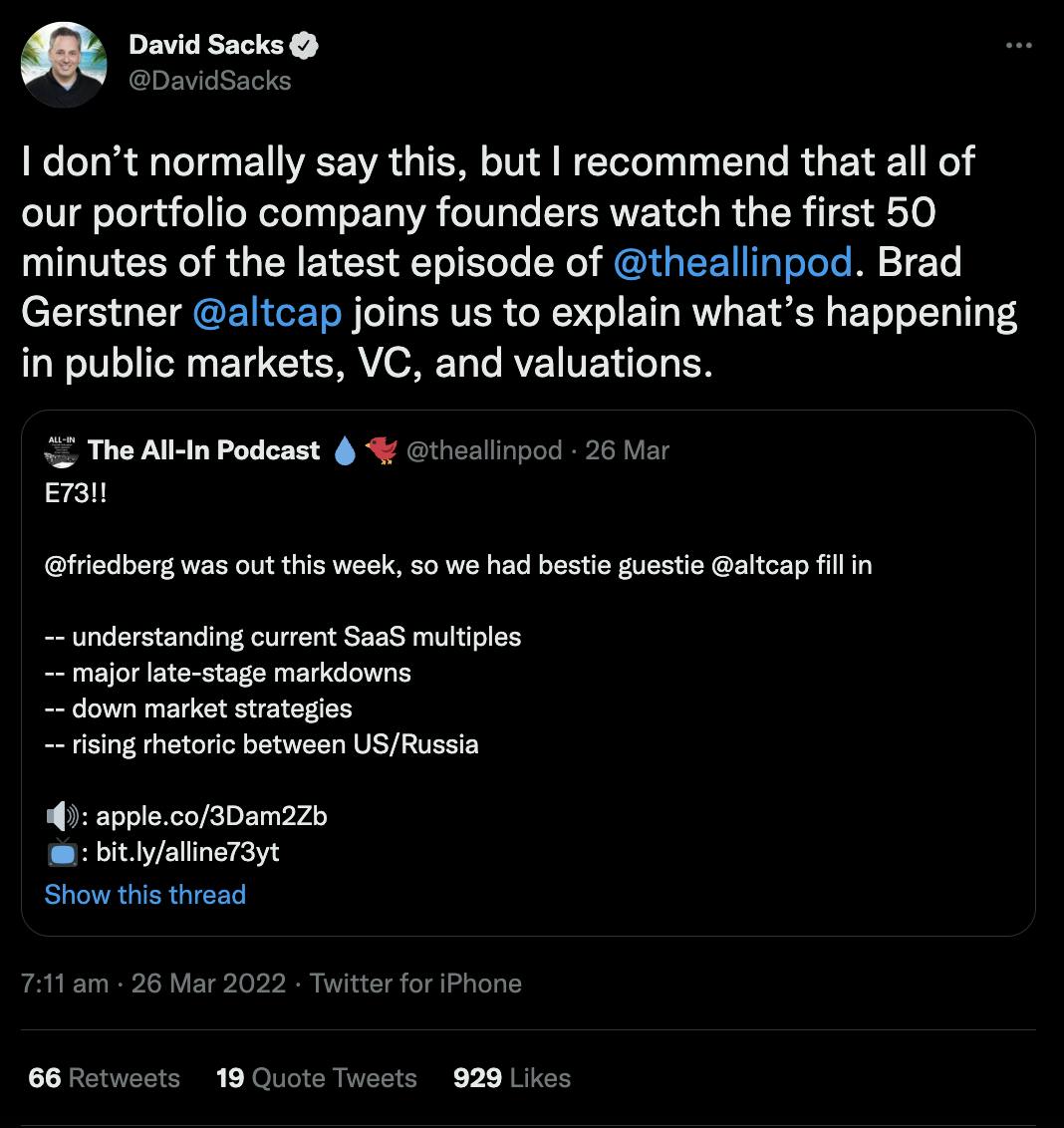With increasing market uncertainty, Jason Calcanis’ All-In Podcast discussed changing SaaS valuations and growth strategies. We listened and picked out the three key lessons for SaaS founders.
“What you exit for is essential to the game.” During the latest episode of the All-In podcast, Brad Gerstner, CEO of Altimeter Capital, explained how stable exit multiples have underpinned strong tech investment over the past decade. However, intense market distortion post-Covid-19 and the uncertainty surrounding the Russia-Ukraine war has ushered in a new era of volatility. The Fed has even predicted that US inflation could reach 4.3% by the end of 2022.
Investors notoriously hate uncertainty, so how will this affect SaaS companies’ funding and valuations over the next 18 months?

Valuations will fall in the short-term
The past decade has seen sky-high SaaS valuations with enterprise SaaS companies seen as synonymous with long-term profitability. But, that is only true for behemoths like Salesforce, explains Social Capital CEO Chamath Palihapitiya. Using the recent example of Instacart slashing their valuation by 40% to $24bn, Palihapitiya notes that people are typically willing to pay eight times top line revenue for a company when rates are zero ($800m for a company with $100m ARR, for example). However, for every 1% rise in rates, you decrease the valuation between 15% and 20%. Therefore, with a minimum 2.5-3% rate expected at the end of year, valuations will fall at least 30-40% and even more if company performance drops or the rates rise further.
Citing Brad Gerstner’s analysis, Craft Ventures Co-Founder David Sacks said that valuations had risen to insane levels during Covid-19 and this expected drop will see valuations revert to the historical average, but this trend could be temporary. According to Palihapitiya, well-run companies can get their valuation back, but “a lot of hard work will need to be done under the covers of these businesses over the next two years for that to happen.”
Internet Index graph – still from All-In podcast Episode 73
Lower valuations could lead to down rounds
‘Down rounds’ are fundraising rounds that are lower than the previous round and in the words of David Sacks, they can lead to a “death spiral” of falling morale, confidence and growth.
Yet, Brad Gerstner thinks that “the vast majority of companies that come public in the next 12 months are going out below their last round of valuation” and late-stage investors of some unicorns could be very disappointed. This is particularly worrying for companies that have been funded at exorbitant valuations when rates were low and operate in a highly saturated market, such as neo-banks and 15-minute delivery companies. As Palihapitiya puts it, “if you are the nth business - not the 1st or 2nd, but the 7th, 8th or 10th trying to go public, and all the seven or eight before you are gas guzzling machines [hoovered up cash when money was cheap], you’re going to pay a very heavy price to go public.”
As a result, some investors are shunning the late-stage private financing market for the time being with Gerstner saying “you couldn’t pry a late-stage dollar out of my hand right now”, adding that “real price discovery” won’t happen until the Fall when companies need money or go public.
In a down market, the three things that matter are growth, burn and margins
David Sacks
Avoid down rounds by focusing on runway and burn
According to David Sacks, “in an up market or a boom market the three things that matter are growth, growth and growth. In a down market, the three things that matter are growth, burn, and margins.” Sacks has been advising his portfolio to lengthen their cash runway to 2-4 years and be more capital efficient to avoid having to raise too quickly and face a potential down round, while also tempering fundraising expectations, stating that “if you raised last year at 100 times ARR, you need to understand that the next time you raise it might be at 20 times ARR.” For him, the key is a good ‘Burn Multiple’ - ensuring you spend less than $2 for every $1 of incremental ARR that you generate - and prioritizing burn over growth at any cost.
For Chamath Palihapitiya, companies that can “go dark” (avoid investment) for 3-5 years can ride out the impending storm, but others will need to control their operations and profitability. At a time when the cost of customer acquisition is going up by 20-40% (due to the increased prices of Facebook and Google etc), bottom-up Saas companies that walk a delicate LTV/CAC line are the most susceptible to rising input costs. The salvation? “Healthy growth margins, healthy contribution margins, and a realistic path to profitability which means being EBITDA positive this year or within the next two years.”
Do you have the cash you need to execute the next phase of your plan?
Running a tight ship
The panel agreed that in a volatile market, public market investors are looking for high-quality and reliable companies with plenty of cash on the balance sheet; the ‘must-own’ companies not the ‘nice-to-own’ companies. In the private market, VCs are going to avoid riskier assets and pay less for quality assets. SaaS founders should broaden their focus away from simply growth, and onto operational efficiency, in order to get control of their unit economics and lengthen their cash runway to be in the best position when the market upturns.
At Paddle, we have 3000 software company clients facing into this environment. As a provider of payments infrastructure for SaaS businesses, there are several key topics coming up in our quarterly business reviews and meetings with potential clients.
Reducing operating costs: Factoring in all elements of payments infrastructure (processing, platform fees, merchant infrastructure, compliance, support and FX) is expensive, and there are no economies of scale when it is built in-house from a variety of tools. This is often the 3rd biggest expenditure item in a software business (after salaries and hosting), and many companies are actively looking for a more efficient solution to improve their margins.
Reducing resource costs: The investment in people needed (both technical and finance) to build, maintain and run a piecemeal payments infrastructure is always more than expected, and a frustrating distraction from running your core business and developing your product. In a growth-at-all-costs market, an endless hiring plan is fine, but in today’s market, automation is absolutely necessary.
Improving retention: Overlooked optimizations such as involuntary churn and payment conversion rates are easy to deprioritize in good times, but they hurt burn rate and impact valuations. Suddenly, these shoot up the task list, as easy wins.
Ensuring compliance: We have seen several funding rounds where compliance issues (eg back taxes for sales tax in multiple regions) have been used as reasons for re-trading on valuation when in fundraising due diligence. As the pressure on valuation multiples is felt over the next months, a strong compliance stance can help defend the company valuation.
The takeaway
Whether sitting pretty with a war chest from a recent fundraise, or getting concerned at the risk of a planned fundraise in late 2022, it’s time to get serious about your operating model. Are you running at the rule of 40? Is your burn multiple under 2? And most importantly, do you have the cash you need to execute the next phase of your plan? Your business can survive almost any crisis, but running out of cash is usually terminal.





